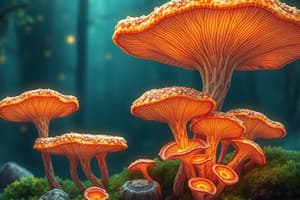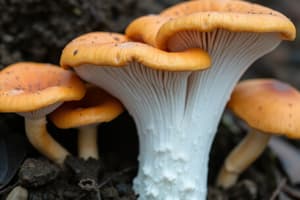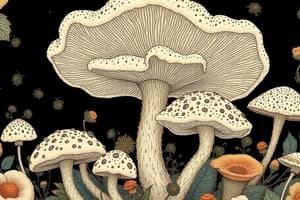Podcast
Questions and Answers
Fungi are ______, _________, or __________ organisms.
Fungi are ______, _________, or __________ organisms.
Eukaryotic, unicellular, multicellular
What is the digestion type found in fungus?
What is the digestion type found in fungus?
Extracellular
What is mycelium?
What is mycelium?
A mesh of microscopic filaments where food absorption takes place.
What are hyphae?
What are hyphae?
What are septa?
What are septa?
Where are most hyphae found?
Where are most hyphae found?
Coenocytic fungi have septa.
Coenocytic fungi have septa.
Fungi cell walls are composed of ______.
Fungi cell walls are composed of ______.
Most fungi are __________ (decomposers) who can break down ______.
Most fungi are __________ (decomposers) who can break down ______.
What are the types of reproduction in fungi?
What are the types of reproduction in fungi?
What happens during karyogamy?
What happens during karyogamy?
A mycologist is a person who studies ______.
A mycologist is a person who studies ______.
What is the Division Mastigomycota characterized by?
What is the Division Mastigomycota characterized by?
What type of reproduction does Class Oömycetes undergo?
What type of reproduction does Class Oömycetes undergo?
What characterizes Class Zygomycetes?
What characterizes Class Zygomycetes?
What type of fungi produce spores in sacs?
What type of fungi produce spores in sacs?
What does Division Deuteromycota signify?
What does Division Deuteromycota signify?
What is mycorrhizae?
What is mycorrhizae?
What ecological roles do lichens play?
What ecological roles do lichens play?
Which of the following are growth types of fungus?
Which of the following are growth types of fungus?
Flashcards are hidden until you start studying
Study Notes
Fungi Overview
- Fungi are eukaryotic organisms that can be unicellular or multicellular.
- They exhibit extracellular digestion, breaking down food with enzymes before absorption.
Structure and Composition
- Mycelium consists of a network of microscopic filaments where nutrient absorption occurs.
- Hyphae are the individual microscopic filaments that compose mycelium.
- Septa are internal crosswalls in hyphae, facilitating organelle movement and sometimes resulting in multi-nucleated cells.
- Chitin is the main component of fungal cell walls, differentiating them from plant cell walls made of cellulose.
Nutritional Ecology
- Fungi are heterotrophs and play a critical ecological role as saprophytes and decomposers.
- Some fungi are parasitic, deriving nutrients from living hosts, while others form mutualistic relationships with plants and algae, such as mycorrhizae and lichens.
Reproductive Strategies
- Asexual reproduction occurs through fragmentation, budding, or the formation of spores.
- Sexual reproduction involves the production of spores following the fusion of dikaryotic nuclei (karyogamy) and subsequent meiosis, leading to genetic variation.
Fungal Classification
- Coenocytic fungi lack septa, leading to a continuous flow of cytoplasm in hyphae.
- The division Mastigomycota includes flagellated spores and cellulose walls, exemplified by water molds.
- Zygomycetes are thread-like fungi that lack crosswalls, reproduce sexually via zygospores, and have specialized hyphae.
- Ascomycetes (sac fungi) have crosswalls, producing asci with ascospores, including yeasts and truffles.
- Basidiomycetes (club fungi) also possess crosswalls and produce basidiospores, with complex life cycles, exemplified by mushrooms.
- Deuteromycota includes imperfect fungi that reproduce asexually; some produce antibiotics, like penicillium.
Symbiotic Relationships
- Mycorrhizae enhance plant nutrient absorption by converting atmospheric nitrogen into a usable form, benefiting both fungi and plants.
- Lichens, a symbiosis between fungi and algae, provide ecological benefits by supporting organisms in harsh environments and pioneering soil formation.
Fungal Growth Forms
- Fungi exhibit various growth forms, including crustose (compact), fruticose (shrub-like), umbillicate, foliose (leaf-like), and squamulose.
Studying That Suits You
Use AI to generate personalized quizzes and flashcards to suit your learning preferences.




